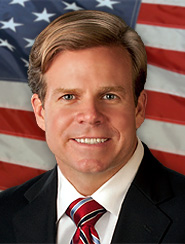Last August, the Republican presidential contender Mitt Romney performed what has become a quadrennial rite of passage in American presidential politics: he delivered a speech to the annual convention of the Veterans of Foreign Wars. His message was rooted in another grand American tradition: hyping foreign threats to the United States. It is “wishful thinking,” Romney declared, “that the world is becoming a safer place. The opposite is true. Consider simply the jihadists, a near-nuclear Iran, a turbulent Middle East, an unstable Pakistan, a delusional North Korea, an assertive Russia, and an emerging global power called China. No, the world is not becoming safer.”
Not long after, U.S. Secretary of Defense Leon Panetta echoed Romney’s statement. In a lecture last October, Panetta warned of threats arising “from terrorism to nuclear proliferation; from rogue states to cyber attacks; from revolutions in the Middle East, to economic crisis in Europe, to the rise of new powers such as China and India. All of these changes represent security, geopolitical, economic, and demographic shifts in the international order that make the world more unpredictable, more volatile and, yes, more dangerous.” General Martin Dempsey, chairman of the Joint Chiefs of Staff, concurred in a recent speech, arguing that “the number and kinds of threats we face have increased significantly.” And U.S. Secretary of State Hillary Clinton reinforced the point by claiming that America resides today in a “very complex, dangerous world.”
Within the foreign policy elite, there exists a pervasive belief that the post–Cold War world is a treacherous place, full of great uncertainty and grave risks. A 2009 survey conducted by the Pew Research Center for the People and the Press found that 69 percent of members of the Council on Foreign Relations believed that for the United States at that moment, the world was either as dangerous as or more dangerous than it was during the Cold War. Similarly, in 2008, the Center for American Progress surveyed more than 100 foreign policy experts and found that 70 percent of them believed that the world was becoming more dangerous. Perhaps more than any other idea, this belief shapes debates on U.S. foreign policy and frames the public’s understanding of international affairs.
In the United States, the chances of dying from a terrorist attack or in a military conflict have fallen almost to zero.
There is just one problem. It is simply wrong. The world that the United States inhabits today is a remarkably safe and secure place. It is a world with fewer violent conflicts and greater political freedom than at virtually any other point in human history. All over the world, people enjoy longer life expectancy and greater economic opportunity than ever before. The United States faces no plausible existential threats, no great-power rival, and no near-term competition for the role of global hegemon. The U.S. military is the world’s most powerful, and even in the middle of a sustained downturn, the U.S. economy remains among one of the world’s most vibrant and adaptive. Although the United States faces a host of international challenges, they pose little risk to the overwhelming majority of American citizens and can be managed with existing diplomatic, economic, and, to a much lesser extent, military tools.
This reality is barely reflected in U.S. national security strategy or in American foreign policy debates. President Barack Obama’s most recent National Security Strategy aspires to “a world in which America is stronger, more secure, and is able to overcome our challenges while appealing to the aspirations of people around the world.” Yet that is basically the world that exists today. The United States is the world’s most powerful nation, unchallenged and secure. But the country’s political and policy elite seems unwilling to recognize this fact, much less integrate it into foreign policy and national security decision-making.
The disparity between foreign threats and domestic threat-mongering results from a confluence of factors. The most obvious and important is electoral politics. Hyping dangers serves the interests of both political parties. For Republicans, who have long benefited from attacking Democrats for their alleged weakness in the face of foreign threats, there is little incentive to tone down the rhetoric; the notion of a dangerous world plays to perhaps their greatest political advantage. For Democrats, who are fearful of being cast as feckless, acting and sounding tough is a shield against GOP attacks and an insurance policy in case a challenge to the United States materializes into a genuine threat. Warnings about a dangerous world also benefit powerful bureaucratic interests. The specter of looming dangers sustains and justifies the massive budgets of the military and the intelligence agencies, along with the national security infrastructure that exists outside government -- defense contractors, lobbying groups, think tanks, and academic departments.
There is also a pernicious feedback loop at work. Because of the chronic exaggeration of the threats facing the United States, Washington overemphasizes military approaches to problems (including many that could best be solved by nonmilitary means). The militarization of foreign policy leads, in turn, to further dark warnings about the potentially harmful effects of any effort to rebalance U.S. national security spending or trim the massive military budget -- warnings that are inevitably bolstered by more threat exaggeration. Last fall, General Norton Schwartz, the U.S. Air Force chief of staff, said that defense cuts that would return military spending to its 2007 level would undermine the military’s “ability to protect the nation” and could create “dire consequences.” Along the same lines, Panetta warned that the same reductions would “invite aggression” from enemies. These are a puzzling statements given that the U.S. defense budget is larger than the next 14 countries’ defense budgets combined and that the United States still maintains weapons systems designed to fight an enemy that disappeared 20 years ago.
Of course, threat inflation is not new. During the Cold War, although the United States faced genuine existential threats, American political leaders nevertheless hyped smaller threats or conflated them with larger ones. Today, there are no dangers to the United States remotely resembling those of the Cold War era, yet policymakers routinely talk in the alarmist terms once used to describe superpower conflict. Indeed, the mindset of the United States in the post-9/11 world was best (albeit crudely) captured by former Vice President Dick Cheney. While in office, Cheney promoted the idea that the United States must prepare for even the most remote threat as though it were certain to occur. The journalist Ron Suskind termed this belief “the one percent doctrine,” a reference to what Cheney called the “one percent chance that Pakistani scientists are helping al Qaeda build or develop a nuclear weapon.” According to Suskind, Cheney insisted that the United States must treat such a remote potential threat “as a certainty in terms of our response.”
Such hair-trigger responsiveness is rarely replicated outside the realm of national security, even when the government confronts problems that cause Americans far more harm than any foreign threat. According to an analysis by the budget expert Linda Bilmes and the economist Joseph Stiglitz, in the ten years since 9/11, the combined direct and indirect costs of the U.S. response to the murder of almost 3,000 of its citizens have totaled more than $3 trillion. A study by the Urban Institute, a nonpartisan think tank, estimated that during an overlapping period, from 2000 to 2006, 137,000 Americans died prematurely because they lacked health insurance. Although the federal government maintains robust health insurance programs for older and poor Americans, its response to a national crisis in health care during that time paled in comparison to its response to the far less deadly terrorist attacks.
Rather than Cheney’s one percent doctrine, what the United States actually needs is a 99 percent doctrine: a national security strategy based on the fact that the United States is a safe and well-protected country and grounded in the reality that the opportunities for furthering U.S. interests far exceed the threats to them. Fully comprehending the world as it is today is the best way to keep the United States secure and resistant to the overreactions that have defined its foreign policy for far too long.
BETTER THAN EVER
The United States, along with the rest of the world, currently faces a period of economic and political uncertainty. But consider four long-term global trends that underscore just how misguided the constant fear-mongering in U.S. politics is: the falling prevalence of violent conflict, the declining incidence of terrorism, the spread of political freedom and prosperity, and the global improvement in public health. In 1992, there were 53 armed conflicts raging in 39 countries around the world; in 2010, there were 30 armed conflicts in 25 countries. Of the latter, only four have resulted in at least 1,000 battle-related deaths and can therefore be classified as wars, according to the Uppsala Conflict Data Program: the conflicts in Afghanistan, Iraq, Pakistan, and Somalia, two of which were started by the United States.
Today, wars tend to be low-intensity conflicts that, on average, kill about 90 percent fewer people than did violent struggles in the 1950s. Indeed, the first decade of this century witnessed fewer deaths from war than any decade in the last century. Meanwhile, the world’s great powers have not fought a direct conflict in more than 60 years -- “the longest period of major power peace in centuries,” as the Human Security Report Project puts it. Nor is there much reason for the United States to fear such a war in the near future: no state currently has the capabilities or the inclination to confront the United States militarily.
Washington should not assume that every problem in the world demands a U.S. response.
Much of the fear that suffuses U.S. foreign policy stems from the trauma of 9/11. Yet although the tactic of terrorism remains a scourge in localized conflicts, between 2006 and 2010, the total number of terrorist attacks declined by almost 20 percent, and the number of deaths caused by terrorism fell by 35 percent, according to the U.S. State Department. In 2010, more than three-quarters of all victims of terrorism -- meaning deliberate, politically motivated violence by nonstate groups against noncombatant targets -- were injured or killed in the war zones of Afghanistan, Iraq, Pakistan, and Somalia. Of the 13,186 people killed by terrorist attacks in 2010, only 15, or 0.1 percent, were U.S. citizens. In most places today -- and especially in the United States -- the chances of dying from a terrorist attack or in a military conflict have fallen almost to zero.
As violence and war have abated, freedom and democratic governance have made great gains. According to Freedom House, there were 69 electoral democracies at the end of the Cold War; today, there are 117. And during that time, the number of autocracies declined from 62 to 48. To be sure, in the process of democratizing, states with weak political institutions can be more prone to near-term instability, civil wars, and interstate conflict. Nevertheless, over time, democracies tend to have healthier and better-educated citizens, almost never go to war with other democracies, and are less likely to fight nondemocracies.
Economic bonds among states are also accelerating, even in the face of a sustained global economic downturn. Today, 153 countries belong to the World Trade Organization and are bound by its dispute-resolution mechanisms. Thanks to lowered trade barriers, exports now make up more than 30 percent of gross world product, a proportion that has tripled in the past 40 years. The United States has seen its exports to the world’s fastest-growing economies increase by approximately 500 percent over the past decade. Currency flows have exploded as well, with $4 trillion moving around the world in foreign exchange markets every day. Remittances, an essential instrument for reducing poverty in developing countries, have more than tripled in the past decade, to more than $440 billion each year. Partly as a result of these trends, poverty is on the decline: in 1981, half the people living in the developing world survived on less than $1.25 a day; today, that figure is about one-sixth. Like democratization, economic development occasionally brings with it significant costs. In particular, economic liberalization can strain the social safety net that supports a society’s most vulnerable populations and can exacerbate inequalities. Still, from the perspective of the United States, increasing economic interdependence is a net positive because trade and foreign direct investment between countries generally correlate with long-term economic growth and a reduced likelihood of war.
A final trend contributing to the relative security of the United States is the improvement in global health and well-being. People in virtually all countries, and certainly in the United States, are living longer and healthier lives. In 2010, the number of people who died from AIDS-related causes declined for the third year in a row. Tuberculosis rates continue to fall, as do the rates of polio and malaria. Child mortality has plummeted worldwide, thanks in part to expanded access to health care, sanitation, and vaccines. In 1970, the global child mortality rate (deaths of children under five per 1,000) was 141; in 2010, it was 57. In 1970, global average life expectancy was 59, and U.S. life expectancy was 70. Today, the global figure is just under 70, and the U.S. figure is 79. These vast improvements in health and well-being contribute to the global trend toward security and safety because countries with poor human development are more war-prone.
PHANTOM MENACE
None of this is meant to suggest that the United States faces no major challenges today. Rather, the point is that the problems confronting the country are manageable and pose minimal risks to the lives of the overwhelming majority of Americans. None of them -- separately or in combination -- justifies the alarmist rhetoric of policymakers and politicians or should lead to the conclusion that Americans live in a dangerous world.
Take terrorism. Since 9/11, no security threat has been hyped more. Considering the horrors of that day, that is not surprising. But the result has been a level of fear that is completely out of proportion to both the capabilities of terrorist organizations and the United States’ vulnerability. On 9/11, al Qaeda got tragically lucky. Since then, the United States has been preparing for the one percent chance (and likely even less) that it might get lucky again. But al Qaeda lost its safe haven after the U.S.-led invasion of Afghanistan in 2001, and further military, diplomatic, intelligence, and law enforcement efforts have decimated the organization, which has essentially lost whatever ability it once had to seriously threaten the United States.
According to U.S. officials, al Qaeda’s leadership has been reduced to two top lieutenants: Ayman al-Zawahiri and his second-in-command, Abu Yahya al-Libi. Panetta has even said that the defeat of al Qaeda is “within reach.” The near collapse of the original al Qaeda organization is one reason why, in the decade since 9/11, the U.S. homeland has not suffered any large-scale terrorist assaults. All subsequent attempts have failed or been thwarted, owing in part to the incompetence of their perpetrators. Although there are undoubtedly still some terrorists who wish to kill Americans, their dreams will likely continue to be frustrated by their own limitations and by the intelligence and law enforcement agencies of the United States and its allies.
As the threat from transnational terrorist groups dwindles, the United States also faces few risks from other states. China is the most obvious potential rival to the United States, and there is little doubt that China’s rise will pose a challenge to U.S. economic interests. Moreover, there is an unresolved debate among Chinese political and military leaders about China’s proper global role, and the lack of transparency from China’s senior leadership about its long-term foreign policy objectives is a cause for concern. However, the present security threat to the U.S. mainland is practically nonexistent and will remain so. Even as China tries to modernize its military, its defense spending is still approximately one-ninth that of the United States. In 2012, the Pentagon will spend roughly as much on military research and development alone as China will spend on its entire military.
While China clumsily flexes its muscles in the Far East by threatening to deny access to disputed maritime resources, a recent Pentagon report noted that China’s military ambitions remain dominated by “regional contingencies” and that the People’s Liberation Army has made little progress in developing capabilities that “extend global reach or power projection.” In the coming years, China will enlarge its regional role, but this growth will only threaten U.S. interests if Washington attempts to dominate East Asia and fails to consider China’s legitimate regional interests. It is true that China’s neighbors sometimes fear that China will not resolve its disputes peacefully, but this has compelled Asian countries to cooperate with the United States, maintaining bilateral alliances that together form a strong security architecture and limit China’s room to maneuver.
The strongest arguments made by those warning of Chinese influence revolve around economic policy. The list of complaints includes a host of Chinese policies, from intellectual property theft and currency manipulation to economic espionage and domestic subsidies. Yet none of those is likely to lead to direct conflict with the United States beyond the competition inherent in international trade, which does not produce zero-sum outcomes and is constrained by dispute-resolution mechanisms, such as those of the World Trade Organization. If anything, China’s export-driven economic strategy, along with its large reserves of U.S. Treasury bonds, suggests that Beijing will continue to prefer a strong United States to a weak one.
NUCLEAR FEAR
It is a matter of faith among many American politicians that Iran is the greatest danger now facing the country. But if that is true, then the United States can breathe easy: Iran is a weak military power. According to the International Institute for Strategic Studies, Iran’s “military forces have almost no modern armor, artillery, aircraft or major combat ships, and UN sanctions will likely obstruct the purchase of high-technology weapons for the foreseeable future.”
Tehran’s stated intention to project its interests regionally through military or paramilitary forces has made Iran its own worst enemy. Iran’s neighbors are choosing to balance against the Islamic Republic rather than fall in line behind its leadership. In 2006, Iran’s favorability rating in Arab countries stood at nearly 80 percent; today, it is under 30 percent. Like China’s neighbors in East Asia, the Gulf states have responded to Iran’s belligerence by participating in an emerging regional security arrangement with the United States, which includes advanced conventional weapons sales, missile defenses, intelligence sharing, and joint military exercises, all of which have further isolated Iran.
Of course, the gravest concerns about Iran focus on its nuclear activities. Those fears have led to some of the most egregiously alarmist rhetoric: at a Republican national security debate in November, Romney claimed that an Iranian nuclear weapon is “the greatest threat the world faces.” But it remains unclear whether Tehran has even decided to pursue a bomb or has merely decided to develop a turnkey capability. Either way, Iran’s leaders have been sufficiently warned that the United States would respond with overwhelming force to the use or transfer of nuclear weapons. Although a nuclear Iran would be troubling to the region, the United States and its allies would be able to contain Tehran and deter its aggression -- and the threat to the U.S. homeland would continue to be minimal.
Overblown fears of a nuclear Iran are part of a more generalized American anxiety about the continued potential of nuclear attacks. Obama’s National Security Strategy claims that “the American people face no greater or more urgent danger than a terrorist attack with a nuclear weapon.” According to the document, “international peace and security is threatened by proliferation that could lead to a nuclear exchange. Indeed, since the end of the Cold War, the risk of a nuclear attack has increased.”
If the context is a state-against-state nuclear conflict, the latter assertion is patently false. The demise of the Soviet Union ended the greatest potential for international nuclear conflict. China, with only 72 intercontinental nuclear missiles, is eminently deterrable and not a credible nuclear threat; it has no answer for the United States’ second-strike capability and the more than 2,000 nuclear weapons with which the United States could strike China.
In the past decade, Cheney and other one-percenters have frequently warned of the danger posed by loose nukes or uncontrolled fissile material. In fact, the threat of a nuclear device ending up in the hands of a terrorist group has diminished markedly since the early 1990s, when the Soviet Union’s nuclear arsenal was dispersed across all of Russia’s 11 time zones, all 15 former Soviet republics, and much of eastern Europe. Since then, cooperative U.S.-Russian efforts have resulted in the substantial consolidation of those weapons at far fewer sites and in comprehensive security upgrades at almost all the facilities that still possess nuclear material or warheads, making the possibility of theft or diversion unlikely. Moreover, the lessons learned from securing Russia’s nuclear arsenal are now being applied in other countries, under the framework of Obama’s April 2010 Nuclear Security Summit, which produced a global plan to secure all nuclear materials within four years. Since then, participants in the plan, including Chile, Mexico, Ukraine, and Vietnam, have fulfilled more than 70 percent of the commitments they made at the summit.
Pakistan represents another potential source of loose nukes. The United States’ military strategy in Afghanistan, with its reliance on drone strikes and cross-border raids, has actually contributed to instability in Pakistan, worsened U.S. relations with Islamabad, and potentially increased the possibility of a weapon falling into the wrong hands. Indeed, Pakistani fears of a U.S. raid on its nuclear arsenal have reportedly led Islamabad to disperse its weapons to multiple sites, transporting them in unsecured civilian vehicles. But even in Pakistan, the chances of a terrorist organization procuring a nuclear weapon are infinitesimally small. The U.S. Department of Energy has provided assistance to improve the security of Pakistan’s nuclear arsenal, and successive senior U.S. government officials have repeated what former Secretary of Defense Robert Gates said in January 2010: that the United States is “very comfortable with the security of Pakistan’s nuclear weapons.”
A more recent bogeyman in national security debates is the threat of so-called cyberwar. Policymakers and pundits have been warning for more than a decade about an imminent “cyber–Pearl Harbor” or “cyber-9/11.” In June 2011, then Deputy Defense Secretary William Lynn said that “bits and bytes can be as threatening as bullets and bombs.” And in September 2011, Admiral Mike Mullen, then chairman of the Joint Chiefs of Staff, described cyberattacks as an “existential” threat that “actually can bring us to our knees.”
Although the potential vulnerability of private businesses and government agencies to cyberattacks has increased, the alleged threat of cyberwarfare crumbles under scrutiny. No cyberattack has resulted in the loss of a single U.S. citizen’s life. Reports of “kinetic-like” cyberattacks, such as one on an Illinois water plant and a North Korean attack on U.S. government servers, have proved baseless. Pentagon networks are attacked thousands of times a day by individuals and foreign intelligence agencies; so, too, are servers in the private sector. But the vast majority of these attacks fail wherever adequate safeguards have been put in place. Certainly, none is even vaguely comparable to Pearl Harbor or 9/11, and most can be offset by commonsense prevention and mitigation efforts.
A NEW APPROACH
Defenders of the status quo might contend that chronic threat inflation and an overmilitarized foreign policy have not prevented the United States from preserving a high degree of safety and security and therefore are not pressing problems. Others might argue that although the world might not be dangerous now, it could quickly become so if the United States grows too sanguine about global risks and reduces its military strength. Both positions underestimate the costs and risks of the status quo and overestimate the need for the United States to rely on an aggressive military posture driven by outsized fears.
Since the end of the Cold War, most improvements in U.S. security have not depended primarily on the country’s massive military, nor have they resulted from the constantly expanding definition of U.S. national security interests. The United States deserves praise for promoting greater international economic interdependence and open markets and, along with a host of international and regional organizations and private actors, more limited credit for improving global public health and assisting in the development of democratic governance. But although U.S. military strength has occasionally contributed to creating a conducive environment for positive change, those improvements were achieved mostly through the work of civilian agencies and nongovernmental actors in the private and nonprofit sectors. The record of an overgrown post–Cold War U.S. military is far more mixed. Although some U.S.-led military efforts, such as the NATO intervention in the Balkans, have contributed to safer regional environments, the U.S.-led wars in Afghanistan and Iraq have weakened regional and global security, leading to hundreds of thousands of casualties and refugee crises (according to the Office of the UN High Commissioner for Refugees, 45 percent of all refugees today are fleeing the violence provoked by those two wars). Indeed, overreactions to perceived security threats, mainly from terrorism, have done significant damage to U.S. interests and threaten to weaken the global norms and institutions that helped create and sustain the current era of peace and security. None of this is to suggest that the United States should stop playing a global role; rather, it should play a different role, one that emphasizes soft power over hard power and inexpensive diplomacy and development assistance over expensive military buildups.
Indeed, the most lamentable cost of unceasing threat exaggeration and a focus on military force is that the main global challenges facing the United States today are poorly resourced and given far less attention than “sexier” problems, such as war and terrorism. These include climate change, pandemic diseases, global economic instability, and transnational criminal networks -- all of which could serve as catalysts to severe and direct challenges to U.S. security interests. But these concerns are less visceral than alleged threats from terrorism and rogue nuclear states. They require long-term planning and occasionally painful solutions, and they are not constantly hyped by well-financed interest groups. As a result, they are given short shrift in national security discourse and policymaking.
To avoid further distorting U.S. foreign policy and to take advantage of today’s relative security and stability, policymakers need to not only respond to a 99 percent world but also solidify it. They should start by strengthening the global architecture of international institutions and norms that can promote U.S. interests and ensure that other countries share the burden of maintaining global peace and security. International institutions such as the UN (and its affiliated agencies, such as the International Atomic Energy Agency), regional organizations (the African Union, the Organization of American States, the European Union, and the Association of Southeast Asian Nations), and international financial institutions can formalize and reinforce norms and rules that regulate state behavior and strengthen global cooperation, provide legitimacy for U.S. diplomatic efforts, and offer access to areas of the world that the United States cannot obtain unilaterally.
American leadership must be commensurate with U.S. interests and the nature of the challenges facing the country. The United States should not take the lead on every issue or assume that every problem in the world demands a U.S. response. In the majority of cases, the United States should “lead from behind” -- or from the side, or slightly in the front -- but rarely, if ever, by itself. That approach would win broad public support. According to the Chicago Council on Global Affairs’ most recent survey of U.S. public opinion on international affairs, less than ten percent of Americans want the country to “continue to be the pre-eminent world leader in solving international problems.” The American people have long embraced the idea that their country should not be the world’s policeman; for just as long, politicians from both parties have expressed that sentiment as a platitude. The time has come to act on that idea.
If the main challenges in a 99 percent world are transnational in nature and require more development, improved public health, and enhanced law enforcement, then it is crucial that the United States maintain a sharp set of nonmilitary national security tools. American foreign policy needs fewer people who can jump out of airplanes and more who can convene roundtable discussions and lead negotiations. But owing to cuts that began in the 1970s and accelerated significantly during its reorganization in the 1990s, the U.S. Agency for International Development (USAID) has been reduced to a hollow shell of its former self. In 1990, the agency had 3,500 permanent employees. Today, it has just over 2,000 staffers, and the vast majority of its budget is distributed via contractors and nongovernmental organizations. Meanwhile, with 30,000 employees and a $50 billion budget, the State Department’s resources pale in comparison to those of the Pentagon, which has more than 1.6 million employees and a budget of more than $600 billion. More resources and attention must be devoted to all elements of nonmilitary state power -- not only USAID and the State Department but also the Millennium Challenge Corporation, the National Endowment for Democracy, and a host of multilateral institutions that deal with the underlying causes of localized instability and ameliorate their effects at a relatively low cost. As U.S. General John Allen recently noted, “In many respects, USAID’s efforts can do as much -- over the long term -- to prevent conflict as the deterrent effect of a carrier strike group or a marine expeditionary force.” Allen ought to know: he commands the 100,000 U.S. troops fighting in Afghanistan.
Upgrading the United States’ national security toolbox will require reducing the size of its armed forces. In an era of relative peace and security, the U.S. military should not be the primary prism through which the country sees the world. As a fungible tool that can back up coercive threats, the U.S. military is certainly an important element of national power. However, it contributes very little to lasting solutions for 99 percent problems. And the Pentagon’s enormous budget not only wastes precious resources; it also warps national security thinking and policymaking. Since the military controls the overwhelming share of the resources within the national security system, policymakers tend to perceive all challenges through the distorting lens of the armed forces and respond accordingly. This tendency is one reason the U.S. military is so big. But it is also a case of the tail wagging the dog: the vast size of the military is a major reason every challenge is seen as a threat.
More than 60 years of U.S. diplomatic and military efforts have helped create a world that is freer and more secure. In the process, the United States has fostered a global environment that bolsters U.S. interests and generally accepts U.S. power and influence. The result is a world far less dangerous than ever before. The United States, in other words, has won. Now, it needs a national security strategy and an approach to foreign policy that reflect that reality.






















